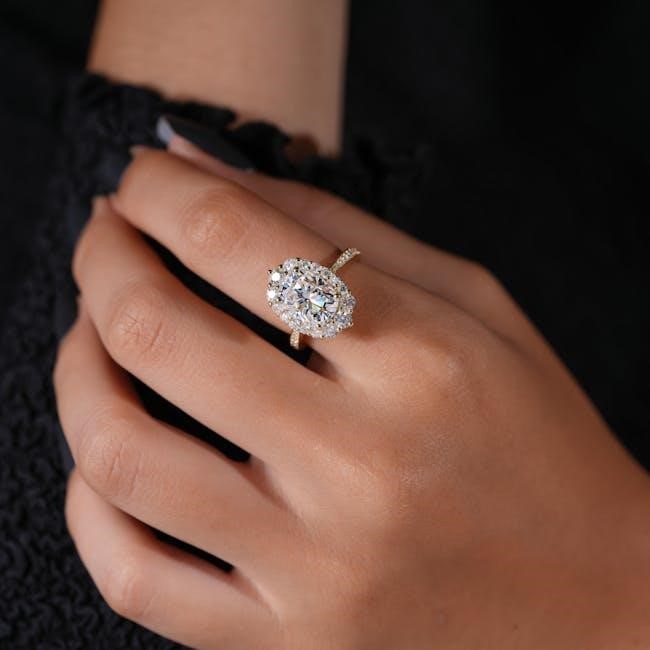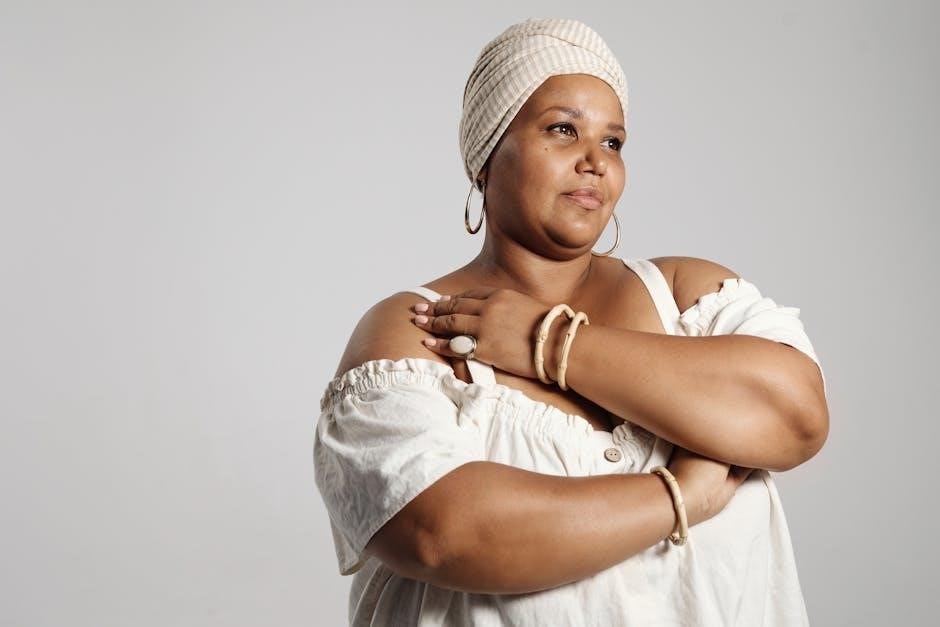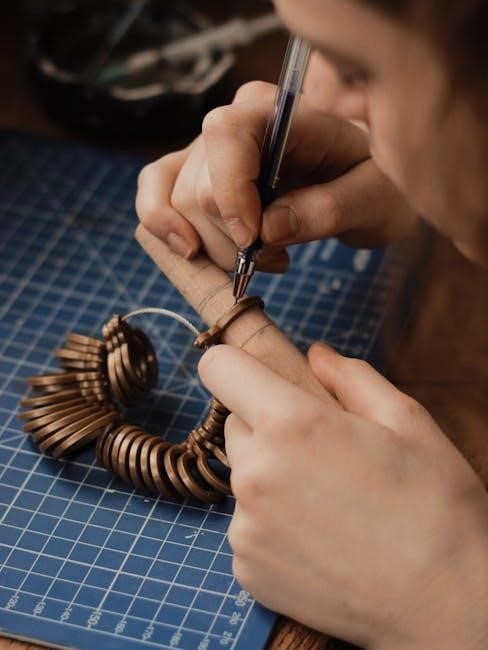
A ring size guide helps determine the perfect fit for your finger, ensuring comfort and style. It’s essential for avoiding resizing and maintaining the ring’s appearance. Learn how to measure accurately and choose the ideal size for any occasion.
1.1 What is a Ring Size Guide?
A ring size guide is a tool or resource designed to help individuals determine their correct ring size. It typically includes charts, measurement techniques, and conversion tables to ensure an accurate fit. The guide often features standardized sizing systems, allowing users to compare sizes across different countries or jewelry brands. By using a ring size guide, one can measure their finger circumference or compare it with an existing ring that fits well. This resource is particularly useful for online shoppers who cannot try on jewelry before purchasing. The guide also educates users on factors influencing ring fit, such as finger shape, knuckle size, and temperature fluctuations. It often provides step-by-step instructions for measuring at home, ensuring a comfortable and secure fit. Whether for personal use or gifting, a ring size guide is an essential tool for making informed purchasing decisions and avoiding resizing hassles. Its universal applicability makes it a valuable asset for anyone seeking the perfect ring fit.
1.2 Importance of Knowing Your Ring Size
Knowing your ring size is crucial for ensuring a comfortable and secure fit. A ring that is too tight may cause discomfort or restrict blood flow, while one that is too loose could slip off easily. Proper sizing is especially important for engagement rings or eternity bands, which are often difficult or expensive to resize. Additionally, knowing your ring size allows you to shop confidently, whether in-store or online. It also helps avoid the inconvenience and potential cost of resizing. Measuring your ring size accurately ensures the jewelry sits properly on your finger, enhancing both its appearance and functionality. Factors like temperature and finger shape can affect sizing, making it essential to measure at the right time and under the right conditions. By determining your exact size, you can enjoy your ring without worries, making it a worthwhile investment for any jewelry lover. Accurate sizing ensures a perfect balance of style and comfort.

Methods to Measure Ring Size
Measure your ring size using a string, tape measure, or printable chart. Compare with an existing ring or wrap a string around your finger for an accurate fit. Ensure comfort and style with the right size.

2.1 Using an Existing Ring
Using an existing ring is a straightforward method to determine your size. Choose a ring that fits the finger you intend to wear the new ring on. Place the ring over the circles on a printable ring size chart, aligning it with the inner edge. Match the diameter and circumference to find the corresponding size. Ensure the ring lies flat and is not tilted for an accurate measurement. If the ring is between sizes, opt for the larger size for comfort. This method is especially helpful when purchasing a ring as a gift, as it allows you to use a ring the recipient already wears. For best results, use a ring with a similar thickness to the one you plan to purchase, as thicker rings may require a larger size. This approach ensures a precise fit without the need for additional tools.
2.2 Measuring Your Finger
To measure your finger, start by cutting a piece of string or paper about 10 centimeters long. Wrap it snugly around the base of your finger, just below the knuckle, marking where the string overlaps. Use a ruler to measure this length in millimeters. Compare your measurement to a standard ring size chart to find your size. For accuracy, measure at the end of the day when fingers are their largest. Avoid measuring when hands are cold, as fingers may be smaller. Consider finger shape; larger knuckles may require a slightly bigger size for comfort. For tool-free measurement, use dental floss or a printable ring size chart. Ensure the ring fits comfortably, not too tight or loose. Patience and multiple measurements ensure consistency. Accurate sizing prevents discomfort and resizing needs. This method is reliable for determining your ring size at home.
2.3 Printable Ring Size Chart
A printable ring size chart is a convenient tool for determining your ring size at home. Download and print the chart, ensuring it’s scaled to 100% for accuracy. Place a well-fitting ring over the circles on the chart to find your size. Alternatively, wrap a string around your finger, mark the overlap, and measure it against the chart’s circumference guide. For the best results, print the chart on high-quality paper and use a ruler to verify measurements. Many jewelers offer printable charts, such as Zales or Cartier, which include detailed instructions. Measure at the end of the day for consistency, as fingers can swell slightly. Consider temperature, as cold hands may result in smaller measurements. This method is ideal for those without access to professional tools, providing a reliable way to find your ring size accurately. Always ensure the chart is printed correctly to avoid sizing errors. This tool is essential for confident online shopping or crafting custom jewelry.

Understanding Ring Size Charts
A ring size chart is a tool matching finger measurements to standard sizes. It includes diameters and circumferences, helping determine the perfect fit. International conversion charts are also provided for clarity.
3.1 Standard Ring Size Chart
A standard ring size chart provides a universal reference for measuring finger circumference or ring diameter. It typically includes numerical or alphabetical sizes, varying across regions. The chart helps match finger measurements to the correct size, ensuring a comfortable fit. By using a tape measure or printable guide, individuals can determine their size accurately. The chart also accounts for factors like temperature and knuckle size, which can affect fit. International conversion charts are often included to compare sizes across different countries, such as US, UK, and EU standards. This comprehensive tool is essential for both buyers and jewelers, offering a reliable way to select or create rings that fit perfectly. Regular updates ensure the chart remains accurate and relevant, adapting to diverse needs and preferences in jewelry sizing.

3.2 International Ring Size Conversion
International ring size conversion is essential for buyers and jewelers alike, as sizing standards vary across countries. The US, UK, and EU use different numerical or alphabetical systems, requiring precise conversion charts. For example, a US size 6 corresponds to a UK size M and an EU size 16.5. These charts typically include diameter and circumference measurements, ensuring accuracy. They also account for variations in sizing systems, such as Russia’s metric-based approach. To convert sizes, compare the internal diameter or circumference of a ring to the standard measurements in the target country’s chart. This process ensures a perfect fit regardless of regional sizing differences. Printable conversion guides and online tools simplify the process, making it easier to match sizes globally. Accurate conversion is crucial for online purchases, avoiding resizing hassles. By understanding international standards, shoppers can confidently buy jewelry from anywhere in the world.
Factors Affecting Ring Size
Temperature, knuckle size, and ring thickness influence ring fit. Fluctuations in temperature can cause finger swelling or shrinking, affecting comfort. Larger knuckles may require a slightly bigger size for easy removal. Thicker rings might need a larger size for a snug fit without discomfort. Lifestyle factors, like hand activity, also play a role in determining the ideal size. Proper measurement techniques and considering these elements ensure the best fit. Accurate sizing avoids resizing and ensures long-lasting wear.
4.1 Temperature and Its Impact
Temperature significantly affects ring size due to its influence on finger swelling. In warmer conditions, fingers tend to swell, making rings feel tighter and potentially restricting movement. Conversely, in colder environments, fingers shrink, causing rings to feel looser. This fluctuation can alter the perceived fit of a ring. To ensure accuracy, measure your finger at room temperature, avoiding extreme heat or cold. For best results, measure at the end of the day when fingers are at their average size. Consider this factor to avoid discomfort and ensure the ring sits comfortably without being too tight or too loose. Proper timing and environmental control are crucial for an accurate measurement. Ignoring temperature changes can lead to sizing errors, emphasizing the importance of measuring under normal conditions for a perfect fit. This ensures long-lasting comfort and prevents the need for future adjustments.
4.2 Knuckle Size Considerations
Knuckle size plays a crucial role in determining the perfect ring fit. A larger knuckle may require a slightly bigger ring size to ensure the ring can slide over it comfortably. Conversely, a smaller knuckle may allow for a more snug fit. It’s important to consider both the finger and knuckle measurements to avoid a ring that is too tight or too loose. The shape of the knuckle, whether round, square, or narrow, can also influence the fit. For instance, a ring may need to be sized up if the knuckle is significantly larger than the finger’s base. Additionally, some individuals may find it challenging to pass the ring over the knuckle, which can affect sizing accuracy. To address this, consider measuring the knuckle’s circumference and comparing it to the ring’s diameter. This ensures the ring can move freely without causing discomfort. Properly accounting for knuckle size is essential for a comfortable and secure fit.
4.3 Ring Thickness and Fit
Ring thickness significantly impacts the fit and comfort of a ring. Thicker rings, typically those with a width of 6mm or more, may require a larger size to accommodate the added bulk. This is because the inner circumference must account for both the finger and the ring’s thickness. Thinner rings, usually under 4mm, tend to fit more snugly and may align closely with the measured finger size. It’s important to consider personal comfort; some prefer thicker rings for durability, while others opt for thinner styles for a more delicate appearance. Additionally, the ring’s profile, whether domed, flat, or beveled, affects how it sits on the finger. For example, a domed ring may feel more substantial, potentially requiring a slightly larger size. Balancing thickness with finger size ensures the ring is both comfortable and visually appealing. Always test the fit or consult a professional to determine the ideal thickness for your ring size.

Choosing the Right Ring Type
Selecting the ideal ring type involves considering finger shape, lifestyle, and personal style. Different styles suit various fingers; for example, wider bands complement slimmer fingers. Assessing your daily activities helps determine durability needs, while style preferences ensure the ring complements your aesthetic, ensuring a perfect blend of comfort and appeal.
5.1 Ring Styles and Finger Shape
When selecting a ring, consider your finger shape to ensure the style complements your hand. For longer fingers, eternity bands or elongated stones enhance elegance, while shorter fingers benefit from halo settings or smaller stones that create a balanced look. Slimmer fingers can handle delicate designs, while thicker bands suit knotty or thicker fingers. Oval or round stones are versatile and flatter most finger types, whereas square or angular stones can add drama to shorter fingers. Petit rings are ideal for smaller hands, while statement pieces suit larger hands. Consider your lifestyle and personal style to ensure the ring aligns with your aesthetic and comfort needs. By matching the ring style to your finger shape, you achieve a harmonious and flattering look that enhances your natural beauty. This thoughtful approach ensures the ring is both stylish and comfortable for everyday wear.
5.2 Lifestyle Considerations for Ring Fit
Your lifestyle plays a significant role in determining the ideal ring fit. For individuals with active jobs or hobbies, a more secure fit is recommended to prevent the ring from slipping off. If you work with your hands frequently, consider a slightly tighter fit to ensure the ring stays in place. For those who engage in sports or physical activities, a sturdy band with a snug fit is advisable. Additionally, if you live in a climate with extreme temperatures, your finger size may fluctuate, so opt for a ring that accommodates these changes. If you plan to wear the ring daily, prioritize comfort and durability. Conversely, for occasional wear, a more fashionable or delicate design may be suitable. Consider your daily routines, such as hand washing or cleaning, as these can affect the ring’s fit and maintenance. Ultimately, aligning the ring’s fit with your lifestyle ensures long-term satisfaction and comfort.
Troubleshooting Common Issues
Address common sizing challenges by ensuring accurate measurements and considering factors like temperature and knuckle size. Solve fit problems with adjustments or resizing, ensuring comfort and proper wearability for any situation.

6.1 Common Mistakes in Measuring
One of the most common mistakes when measuring ring size is not considering temperature fluctuations, as fingers swell in heat and shrink in cold. Measuring too tight or loose can lead to discomfort or a ring that slips off. Many people overlook the knuckle size, which can affect how easily the ring slides on. Using a string that’s too thick or thin may result in inaccurate measurements. Additionally, measuring at the wrong time of day—such as when fingers are swollen—can lead to sizing errors. It’s also important to ensure the ring can pass over the knuckle comfortably. Avoid rushing the process, as this increases the likelihood of mistakes. Always double-check measurements and consider professional assistance if unsure. Accurate sizing ensures a perfect fit, so taking the time to measure correctly is essential for long-term satisfaction with your ring.
6.2 Solutions for Difficult Fits
For individuals with challenging finger shapes or sizes, several solutions can ensure a comfortable and secure fit. Resizeable rings or adjustable bands are ideal for those whose size fluctuates. Using a ring sizer or mandrel can help determine the precise fit. If knuckles are large, consider a ring with a wider band or a comfort fit design that accommodates the knuckle. For smaller fingers, thinner bands may be more appropriate. Some jewelers offer custom sizing options to cater to unique needs. Additionally, ring guards or sizing beads can be added to prevent the ring from slipping off or spinning. It’s also advisable to consult a professional jeweler for expert guidance, especially for unusual or hard-to-fit cases. These solutions ensure that the ring remains comfortable and secure, regardless of individual challenges. Proper fit is crucial for both aesthetics and wearability, making these solutions valuable for long-term satisfaction.
6.3 When to Consult a Professional
There are instances when consulting a professional jeweler is the best course of action for determining ring size. If you’re unsure about your size or have an unusually shaped finger, a jeweler can provide precise measurements using specialized tools. Custom or bespoke rings often require professional sizing to ensure a perfect fit. Additionally, if you’re purchasing a high-value or heirloom piece, a professional’s expertise can prevent costly mistakes. For difficult fits, such as large knuckles or unique finger shapes, jewelers can offer tailored solutions like ring guards or resizing options. They can also assist with international size conversions and resizing existing rings. Don’t hesitate to seek expert advice for complex cases or when accuracy is critical. A professional’s guidance ensures long-term satisfaction and avoids potential discomfort or inconvenience.
Accurate ring sizing ensures comfort and style. Use existing rings, printable charts, or professional jewelers for precise measurements. Remember, the right fit enhances both appearance and wearability, making it worth the effort to get it just right.
7.1 Summary of Key Points
Measuring ring size accurately is crucial for comfort and style. Use an existing ring, a printable chart, or a string to determine your size. Temperature affects finger size, so measure at the end of the day when fingers are at their average size. Consider knuckle size and ring thickness for a snug fit. Avoid measuring when hands are cold or hot, as this can lead to incorrect sizing. Printable guides and online tools provide reliable methods for precise measurement. International conversion charts help match sizes across different regions. For thicker rings, consider sizing up. Professional jewelers can offer expert guidance for difficult fits. Remember, the right size ensures the ring slides on easily but stays securely in place. Always double-check measurements for accuracy to avoid resizing hassles. With these tips, finding the perfect fit becomes straightforward and stress-free.
7.2 Final Tips for a Perfect Fit
For a flawless fit, measure your finger at the end of the day when it’s at its average size. Consider your lifestyle—active individuals may prefer a slightly looser fit. Use a printable ring size chart or a string method for accuracy. If unsure, size up for thicker rings, as they require more space. Ensure the ring slides on easily but doesn’t slip off. Avoid measuring when hands are cold, as fingers can be smaller. Double-check measurements for consistency. If difficulty arises, consult a professional jeweler for precise sizing. Remember, comfort is key, so prioritize a balance between snugness and ease of movement. By following these tips, you’ll ensure a perfect fit that enhances both style and comfort, making your ring a treasured accessory for years to come.
Leave a Reply
You must be logged in to post a comment.